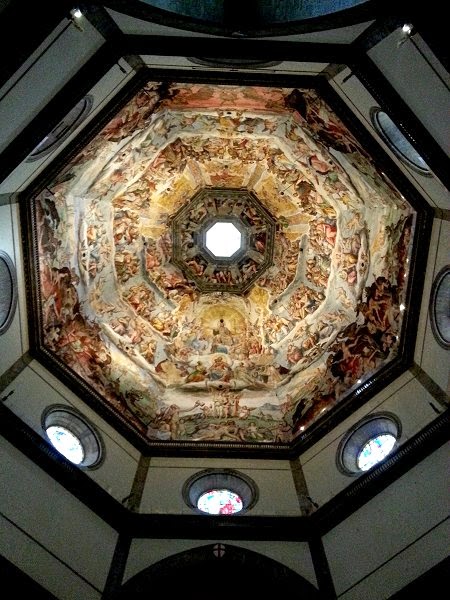The palace was bought by the Medici family in 1549 and became the chief residence of the ruling families of the Grand Duchy of Tuscany. It grew as a great treasure house as later generations amassed paintings, plates, jewelry and luxurious possessions. ( ... more about the Medici family in a later blog posting ... )
The Palazzo remained the principal Medici residence until the last male Medici heir died in 1737. It was then occupied briefly by his sister, the elderly Electress Palatine; on her death, the Medici dynasty became extinct and the Palazzo passed to the new Grand Dukes of Tuscany.
In the late 18th century, the palazzo was used as a power base by Napoleon during his domination of Italy, and later served for a brief period as the principal royal palace of the newly united Italy. The palace and its contents were donated to the Italian people by King Victor Emmanuel III in 1919, and its doors were soon thereafter opened to the public as one of Florence's largest art galleries. Today, it houses several minor collections in addition to those of the Medici family, and is fully open to the public.
Unfortunately photography is not permitted inside the galleries - so I'm sorry but you'll just have to imagine the grandeur of the rooms and the extraordinary treasures contained therein ...
The Palazzo is divided into
five separate art galleries and a museum, housing not only many of its
original contents, but priceless artefacts from many other collections
acquired by the state.
The interior rooms of the palazzo have been largely altered since the
era of the Medici, most recently in the 19th century. Some of the rooms
are quite small and intimate, and, while still grand and gilded, are
more suited to day-to-day living requirements of the ruling families.
I did manage to "sneak" a few photographs of statuary during my wanderings of the Palazzo - but usually only on stairwells and in courtyards out of range of the guards ... !!! ...









The Boboli Gardens
Land on the
Boboli Hill at the rear of the Palazzo was acquired by the Medici family
in order to create a large formal park and gardens, today known as the
Bodoli Gardens.
The Gardens - rising up behind the Palazzo - are some of the first and most familiar formal 16th-century Italian gardens. The mid-16th-century garden style, as it was developed here, incorporated longer axial developments, wide gravel avenues, a considerable "built" element of stone, the lavish employment of statuary and fountains, and a proliferation of detail, coordinated in semi-private and public spaces that were informed by classical accents.
The openness of the garden, with an expansive view of the city, was unconventional for its time. The gardens were very lavish, considering no access was allowed outside the immediate Medici family, and no entertainment or parties ever took place in the gardens.
The garden area lacks a natural water source, so to water the plants in the garden, a conduit was built from the nearby Arno River to feed water into an elaborate irrigation system.
The gardens have passed through several stages of enlargement and restructuring work. They were enlarged in the 17th century to their present extent of 45,000 meters² (11 acres).
The
Boboli Gardens have come to form an outdoor museum of garden sculpture
that includes Roman antiquities as well as 16th and 17th century works.
Scene from the back of the Gardens are the beautiful Tuscan hills with olive tree plantations ...
More from Florence soon ...








































































